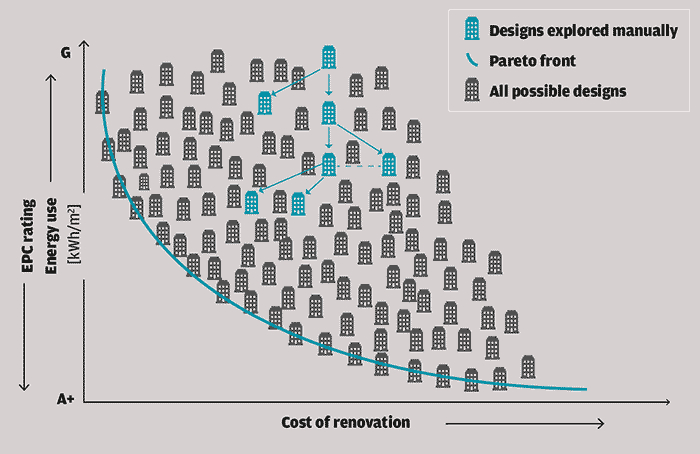Dr Parag Rastogi, lead building physicist at proptech firm arbnco, explores how the power of Artificial Intelligence (AI) and machine learning can be harnessed to optimise energy efficiency in buildings
Artificial Intelligence and machine learning are increasing in prominence in the building, architecture and construction sectors. One area that is ideally suited to take advantage of these powerful new technologies is building energy simulation.
There are various reasons why building energy modelling is a vital resource. Whether it is to demonstrate compliance with legislation such as the Minimum Energy Efficiency Standards (MEES) through EPCs, increase energy efficiency, or investigate poor performance, the ability to simulate what-if scenarios is crucial to informed decision-making.
The current applications of AI on the market now do not replace human judgement. Rather, where AI comes into play is the ability to run millions of calculations in seconds to ensure feasible options are not disregarded for lack of time or resources for analysis.
Removing laborious manual calculations frees up energy assessors to use their time to greater effect, creating more value for the end client. It would be impossible to build a perfect energy model of every individual commercial property, and every renovation option. Collecting and analysing data at scale is an expensive and slow undertaking, even if the data exists. Ultimately, therefore, AI enables scalability.
The promise of AI is that it solves the bulk of the problem – processing 80% of the options can allow the user to focus in on the 20% – ultimately increasing efficiency and using their expertise to greatest effect. AI will be an important lever to unlock the potential of building physics to improve design, engineering, and architecture. Digitising the shelves and shelves of documents about buildings will mean that every element of a building becomes more searchable and accessible, making problems easier to detect, locate and solve.
Conscious & unconscious bias
Given the hundreds of variations and thousands of combinations to consider in any given building, energy managers use their experience and knowledge to make recommendations on retrofit strategies. When doing so they are making judgements based on unconscious and conscious bias – for example, making the assumption that a particular retrofit strategy will succeed because it had a positive impact in a previous similar project.
By running a very large number and combination of options and strategies, AI and machine learning can help remove that bias, suggesting options the assessors themselves may not have thought of. Every facilities manager and energy assessor has different knowledge and experience, and with that comes blind-spots, which this process could help reduce.
So, is AI really coming for our jobs?
AI isn’t perfect, it certainly doesn’t replace judgement or engineering education; often the first piece of advice given to engineers exploring AI is that if you put garbage in, then you will get garbage out. Data quality and quantity are both crucial.
Where its strength lies is in identifying patterns faster, with potentially better accuracy. Ultimately, AI and machine learning are new mathematical tools that must be adapted for purpose. It isn’t a case of simply introducing them into the analysis and expecting a miracle. In any case, the smartness and appropriateness of the recommendations is irrelevant if they are not acted upon in the physical world!
Applying machine learning to retrofit exploration

My interest in applying machine learning to building simulation stems back to my extended research stay at the RIKEN Institute for Advanced Intelligence Project in Tokyo, Japan, where I collaborated with Dr Mohammad Emtiyaz Khan, a world-leading researcher in data science and machine learning.
In August 2017, I was given the opportunity to build upon our experiments thanks to funding from The Data Lab, an innovation centre focused on helping Scottish industry collaborate with public sector and universities to promote the use of data science and artificial intelligence.
The nine-month research project enabled building energy simulation company arbnco to work with the Department of Architecture at the University of Strathclyde to understand how best to introduce AI in building simulations.
The project focused on the arbn consult platform software which provides the ability to quickly and accurately assess the Energy Performance Certificate (EPC) rating of a commercial property, producing bespoke and fully-costed retrofit packages for delivering improvements in energy performance.
The software, based on the industry-standard Simplified Building Energy Model (SBEM), tracks regulated energy loads, fixed building services such as heating, cooling, lighting, controls, ventilation, hot water, fuel and refrigerants.
Using this energy model, the platform delivers an analysis of commercial real estate improvements to determine retrofit strategies for mitigating risk and improving financial performance of commercial real estate.
Project outcomes
Our team of researchers combined expertise in building science, machine learning, automation in construction, software, and building simulation. Over the course of the project we explored ways that machine learning can be used in tandem with building simulation software to make quicker, more informed decisions.
The research project enabled arbnco to upgrade its existing retrofit-exploration software arbn consult. The arbn consult software offers users the possibility of a Multi Objective Optimisation, taking into account both EPC ratings and costs to retrofit commercial properties. Users can input constraints such as cost or payback period to determine the optimum retrofit strategy.
arbnco’s product offering is currently based on UK compliance software. Going forward, it intends to apply this research to dynamic energy modelling software such as Energy Plus, developed by the US Department of Energy, and ESP-r, developed by the University of Strathclyde, to increase global usage.
If you enjoyed this article, subscribe to our email newsletter or print / PDF magazine for FREE








